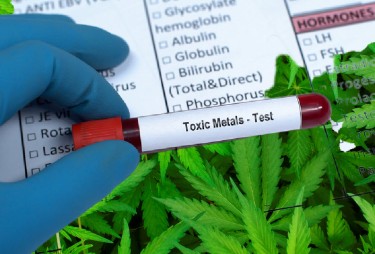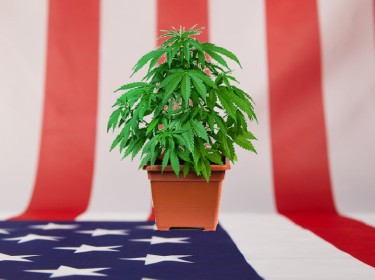Cannabis News
Beggar Thy Neighbor's Tax Dollars? – Wisconsin Residents Gave the State of Illinois $36 Million in Cannabis Tax Revenue
Published
1 year agoon
By
admin

According to a recent state estimate, Illinois has collected a whopping $36 million in tax revenue from Wisconsin residents crossing the border to purchase marijuana in Illinois, where cannabis use has been legalized. This astounding number highlights the tremendous effect legalization could have on the state economy and attitudes toward marijuana use.
You may like
-


How Worried Should You Be about Heavy Metals in Your Rolling Papers?
-


All The Ways To Consume Cannabis
-


5 Best Ways to Break The Doomscrolling Habit
-


Marijuana MicroDosing Can Improve Mundane Tasks
-


10 Coloradans could win the rights to license plates with cannabis-themed phrases
-


Unleashing the Therapeutic Potential of High CBD Seeds
Cannabis News
How Worried Should You Be about Heavy Metals in Your Rolling Papers?
Published
2 mins agoon
April 25, 2024By
admin

Inhaling dangerous metals from rolling papers is a possible health risk for cannabis users, according to a recent study published in ACS Omega. These studies had high concentrations of heavy metals such as copper, chromium, and vanadium, which alarmed researchers since they may pose health problems.
The investigation delved into the metal composition of 53 varieties of rolling papers and cones widely used in the cannabis industry. The findings should serve as a warning to both occasional and frequent cannabis consumers alike.
Uncovering Significant Findings and Associated Health Risks
The investigative team at Michigan’s Lake Superior State University embarked on a thorough examination of 53 different types of rolling papers and cones utilized within the cannabis industry. Their findings, published in ACS Omega, revealed a startling discovery: approximately one-quarter of the tested products surpassed established safety thresholds for metal inhalation, with copper levels being particularly noteworthy. These heightened concentrations were notably prevalent in papers featuring colorful designs or metallic embellishments, often favored for their aesthetic appeal by consumers.
Of grave concern to researchers was the potential neurological impact of these metals, especially when present in colored papers. The study underscores the alarming prospect of neurotoxic effects linked to prolonged exposure, potentially implicating a heightened risk of neurodegenerative diseases. Derek Wright, co-author of the study, expressed dismay at the lack of governmental oversight, particularly in states where regulations for cannabis flowers do not extend to rolling papers. This regulatory gap underscores the urgency for comprehensive oversight to safeguard consumers, especially those relying on cannabis for therapeutic purposes.
Wright’s observations illuminate a disconcerting reality: many consumers assume that regulatory bodies oversee the safety of products associated with cannabis consumption. However, the absence of stringent regulations surrounding rolling papers poses a tangible threat to public health, particularly for vulnerable populations. Individuals leveraging cannabis for medicinal purposes, often grappling with pre-existing health conditions, could unknowingly expose themselves to further harm through the inhalation of toxic metals.
In essence, the study’s revelations serve as a clarion call for swift action within the industry and regulatory spheres. Strong supervision procedures must be put in place as soon as possible, and safety regulations must be strictly followed in all areas of cannabis use. In addition to endangering customer safety, delaying the resolution of these issues damages the legitimacy and long-term viability of the emerging cannabis industry.
Advocating for Industry Response and Regulatory Reform
The cannabis business and regulatory agencies have both loudly called for action in response to the release of these data. Concerned about the study’s ramifications, experts stress the urgent need for stricter laws and a radical change to safer production methods. Co-author of the research Derek Wright emphasizes how crucial it is to pinpoint the origins of potentially dangerous compounds in order to facilitate the creation of safer goods.
Daniel Curtis, an analytical and atmospheric chemist consulted on the matter, underscores the importance of future research endeavors. He advocates for a deeper understanding of how metals transfer from rolling papers through the combustion process. Such insights could inform targeted interventions aimed at mitigating exposure risks and enhancing consumer safety. With cannabis consumption on the ascent, the imperative to identify and address sources of toxic chemicals grows ever more urgent.
The study’s consequences go well beyond the confines of scholarly research and have a significant impact on the hallways of industry. In order to put consumer welfare first and enact evidence-based reforms, stakeholders must work together in a coordinated effort. Regulatory agencies may protect the public’s health and promote innovation by establishing a culture of openness and responsibility. In order to overcome these obstacles and reach its full potential as a catalyst for responsible growth, the cannabis sector will need to work together and demonstrate unshakable dedication.
Pioneering Safer Smoking Solutions: Innovations Towards Harm Reduction
As worries about the safety of rolling papers grow, forward-thinking businesses are leading campaigns to reduce dangers and encourage safer smoking environments. Leading the pack of these innovators is RAW, which is well-known for its dedication to transforming the cannabis industry. In their most recent project, RAW presents a novel rolling paper designed to reduce any impurities while highlighting the organic tastes found in cannabis. With a focus on the health and happiness of the customer, this invention signifies a paradigm change in product design.
The foreword to RAW’s groundbreaking study highlights the industry’s increasing realization of how important it is to give damage reduction methods top priority. RAW is working to raise the bar for cannabis accessory safety and purity by using state-of-the-art manufacturing methods and strict quality control procedures. The notably thinner paper not only makes smoking more enjoyable, but also demonstrates RAW’s ongoing commitment to customer welfare.
Beyond product innovation, RAW’s mission represents a larger culture of business responsibility and social concern. By promoting safer smoking options, the firm hopes to provide customers with educated choices and build a harm-reduction culture within the cannabis community. Furthermore, RAW’s proactive strategy establishes a precedent for industry-wide collaboration and responsibility, igniting a collective effort to solve systemic concerns while maintaining the greatest levels of safety and integrity.
Customer safety must continue to be the priority as the cannabis business develops and diversifies. RAW’s creative efforts are a ray of hope, encouraging other industry participants to take the lead in damage reduction. Through leveraging innovation and teamwork, the cannabis sector may steer towards a more secure and sustainable future where the welfare of users is the top priority.
Bottom Line
The study’s findings underscore the urgent need for regulatory reform and industry response to address the presence of toxic metals in commercially available cannabis rolling papers. With significant health risks posed by inhaling heavy metals such as copper, chromium, and vanadium, consumers, especially those using cannabis for therapeutic purposes, are at risk. The absence of stringent regulations governing rolling papers highlights a critical gap in oversight, emphasizing the necessity for comprehensive safety measures to safeguard public health. Advocacy for safer production practices and innovative solutions, exemplified by initiatives like RAW’s pioneering rolling paper, is essential to mitigate risks and promote harm reduction within the cannabis community. Ultimately, prioritizing consumer safety and implementing evidence-based reforms are paramount for the sustainable growth and legitimacy of the emerging cannabis industry.
TOXIC METAL LEVELS IN CANNABIS, READ ON…
WHY ARE HEAVY METALS TESTING OUT SO HIGH IN CANNABIS USERS BLOOD?


A Guide to Stoned Parenting
As the legalization and normalization of cannabis continues to spread across the globe, it’s becoming increasingly common for parents to use marijuana. This trend shows no signs of slowing down – in fact, it’s likely that the number of parents who smoke cannabis will only grow in the coming years. While this may be an uncomfortable reality for some, it’s a fact that we as a society need to face head-on.
Interestingly, being a “stoned parent” isn’t necessarily a bad thing. For those dealing with the often overwhelming stresses of parenting young children, a little cannabis buzz could actually be helpful in some ways.
It may allow you to keep your cool during a toddler’s 20th tantrum of the day, or help you smile through yet another mind-numbing repetition of “Baby Shark.” Of course, moderation and responsibility are key – no one is advocating getting completely baked while on full-time daddy or mommy duty.
However, even as cannabis use becomes more accepted and mainstream, it’s crucial for pot-smoking parents to be mindful of the unique challenges and considerations that come with this lifestyle choice. Unfortunately, social stigma around parents using cannabis still very much exists.
Additionally, at each stage of a child’s development, parents need to navigate age-appropriate ways of discussing and modeling responsible substance use, whether that substance is marijuana, alcohol, or something else.
The goal of this article is to explore some of the key things that parents who use cannabis should keep in mind as they strive to raise healthy, well-adjusted kids in a world where weed is increasingly widespread.
We’ll look at everything from keeping your stash safely out of little hands to talking to your teens about responsible cannabis consumption. While it may sometimes feel like a balancing act, it’s absolutely possible to be a great parent and responsibly enjoy cannabis too. Let’s dive in and talk about how.
As a parent who uses cannabis, one of the most important things to understand is that your children are constantly observing and learning from your behavior. Kids are like little sponges, soaking up everything they see and hear, and then using that information to build their own models of how to act and react in the world. This process, known as modeling, is one of the primary ways that children learn and develop their core habits and behavior patterns.
What does this mean for you as a cannabis-using parent? Simply put, you need to be very mindful of how you consume and talk about marijuana in front of your kids. If you frequently use cannabis to cope with stress or anger, for example, your child may internalize the idea that this is an appropriate way to deal with difficult emotions. Similarly, if you’re always lounging around stoned and unmotivated, your kid may come to see that as normal adult behavior.
Now, this isn’t to say that you can never consume cannabis in front of your children. In fact, as weed becomes more socially accepted, it’s important for kids to understand that it’s something some adults do – similar to drinking alcohol. The key is to differentiate between “adult use” and “child use.” Starting around age 5, and certainly by age 8 and up, you should begin explaining to your child that some things, like cannabis and alcohol, are only for grown-ups.
Of course, an essential part of responsible cannabis use as a parent is keeping your stash well out of reach of curious little hands. Kids have an uncanny ability to find things they shouldn’t, so it’s critical to lock up your weed, edibles, and paraphernalia. Consider investing in a lockbox or designating a specific “off-limits” area that your children know is strictly forbidden. And even within your secure storage spot, it never hurts to have an extra “decoy” box in case crafty kids make it that far.
When you do consume cannabis in front of your children, try to do so as naturally and responsibly as possible. Taking a discreet hit from a vape pen or pipe, then going about your day as normal, helps reinforce the idea that this is simply part of some grownup’s routine – not something illicit. That said, discretion and moderation are important. Don’t lounge around with a huge bong all day, or consume to the point that you’re noticeably impaired while primary parenting. If you need to take a smoke break, step away, consume quickly, then rejoin your kids with a clear head.
Ultimately, by modeling responsible cannabis use, securely storing your stash, and openly discussing the differences between “grown-up substances” and “kid-friendly” ones, you can help your children develop a healthy, well-adjusted understanding of marijuana’s role in some adult’s lives. It’s all about striving for that balance between normalization and necessary age-appropriate boundaries.
At some point you’ll need to have a conversation (or more likely, a series of conversations) with your child about marijuana. Navigating these talks can feel tricky, but the key is to go in with a clear idea of the core message you want to convey in order to foster a healthy understanding of cannabis in your child’s mind.
When your kids are young, usually simple, straightforward answers are best. If they ask about your cannabis use, you don’t need to get into the nitty-gritty details. Just offer a brief, age-appropriate explanation that satisfies their curiosity while reinforcing the idea that marijuana is something only for adults. You might say something like, “This is a special plant that helps mommy relax sometimes, but it’s just for grown-ups, not for kids.”
However, as your children get older and enter their teenage years, it’s important to revisit and expand upon the cannabis conversation. By this age, it’s highly likely that your kid will encounter marijuana in some social setting with their peers. As a parent, you want them to be prepared for this.
While every family will handle this differently based on their own values and circumstances, I personally believe in being upfront and realistic. Assuming you used cannabis yourself as a teen, it would feel hypocritical to completely forbid your own child from experimenting.
That said, you can explain to them that trying any psychoactive substance, including weed, fundamentally changes their brain chemistry and the way they experience the world. Advise them that waiting until they are older, and their brain is more fully developed, is the wisest and safest choice.
You might also let them know that if and when they do decide to experiment with cannabis, you would much rather they do so with you in a safe, controlled environment than with a random peer. Emphasize that you will not judge or punish them for being curious, and that your door is always open for honest conversations.
In many cases, when parents are transparent about their own cannabis use and take an open, educational approach rather than a strictly prohibitive one, it creates a foundation of trust and safety. Your teen knows they can come to you with questions or for help, and that you’re a reliable, knowledgeable resource. Plus, let’s be real – the weed you have stashed away is probably way better than whatever their friends are smoking behind the bleachers.
Ultimately, the goal of these ongoing conversations is to equip your child with the information and critical thinking skills they need to make responsible decisions about cannabis, both now and in the future. By fostering open, honest dialogue and leading by example, you’re setting them up for success no matter what they choose.
Let’s face it – being a parent is tough. It’s a 24/7 job with no pay, no sick days, and a whole lot of bodily fluids. Add in the lingering social stigma around cannabis use, and it can feel like an uphill battle to be a stoner parent in a world that still largely frowns upon marijuana.
But here’s the thing: if you’re a responsible, loving, involved parent who just happens to enjoy a little green now and then, you’re doing a fantastic job. Period.
Sure, you might have to be a bit more discreet about your cannabis use than you’d like, especially around judgy PTA moms or nosy neighbors. And yes, you’ll need to be extra mindful about storing your stash safely and talking to your kids about marijuana in an age-appropriate way. But at the end of the day, if you’re showing up for your children with presence, patience, and unconditional love (even if you’re a little baked while doing it), you’re acing this whole parenting thing.
So to all the stoner mamas and papa bears out there: keep on toking and keep on rocking this child-rearing gig. Ignore the haters, trust your intuition, and know that you’re providing your kids with everything they really need.
Because when you get down to the sticky bottom line, the most important thing is that your little ones feel safe, supported, and totally adored. And if a responsible cannabis habit helps you be the best version of yourself as you navigate the wild ride of parenthood, then blaze on, my friend. You’ve got this.
CANNABIS USE AND PARENTING, READ ON…
Cannabis News
Nearly 50% of Biden Supporters Want a Dispensary Within Driving Distance, Only 12% of Trump Supporters Feel the Same Way
Published
1 day agoon
April 24, 2024By
admin

NIMBY stands for “Not in My Back Yard”, and when discussing cannabis, Republicans and Democrats could not be more diametrically opposed on living in certain area with or without legal weed.
The recently released report from Redfin, a technology-enabled real estate brokerage, is circulating in the marijuana industry. It revealed a noticeable difference between individuals living in U.S. households that favoured Joe Biden versus Donald Trump. The major difference pertains to individual preference when it comes to residing in areas where recreational cannabis is legal.
According to the survey done by Qualtrics in February 2024, 46.8% of individuals who will cast their votes for Joe Biden in the forthcoming presidential election said they want to reside in places where recreational marijuana is allowed. Another recent Harris Poll showed nearly 60% of American voters now believe you should be able to grow your own cannabis at home. On the other hand, 12.4% of those who wanted to vote for Donald Trump chose the same option.
The survey, which involved up to 2,995 U.S. homeowners and renters, shared a complex standpoint. 36% of those surveyed responded that they are generally interested in residing in a place where cannabis is legalized for recreational purposes. On the other hand, about one-third of the respondents, 32.3%, rejected such states, and 41.3% showed no preference.
The findings signal the exciting new phase of marijuana legalization in the United States. Right now, it is legal to consume marijuana recreationally in 24 states and D.C., while a few other states are contemplating legalizing it as well. This evolving legal environment impacts Americans’ attitudes towards housing through their political approach.
The inquiry reveals that politics, public attitudes, and real estate are interlinked in many ways. As the debates on cannabis legalization are underway at both state and federal levels, these different dynamics leave many uncertain about how they will impact real estate trends and market dynamics.
College Graduates, High Earners, and Remote Workers Prefer living in Legalized Recreational Cannabis States.
The report from Redfin takes an in-depth look into the impact of recreational marijuana on the composition of the population and what types of areas they prefer to live in. Among the individuals earning at least $100,000 per year, more than one-third (35.2%) desired to live in legalized recreational cannabis states, representing a genuine interest in this income bracket.
On the other hand, the percentage decreases to about a quarter (25.9%) for those who earn between $50,000 and $100,000. It drops even further to approximately one-quarter (23.2%) for the group who earn less than $50,000.
Also, the research results illustrate a connection between the educational level and the recreational marijuana use acceptance. Participants who had college degrees and who held greater earning power overwhelmingly favored passing these bills.
Those with a college degree or higher (35.6% of their category) showed the highest preferences about residing where marijuana is allowed for recreational use. Meanwhile, only 17.7% and 20.3% of those holding and not holding their high school diploma showed similar desires.
Similarly, the survey also discovers a relationship between remote work and residents’ choice to live in areas where marijuana is legal. According to that sentiment, those who prefer to work remotely were significantly more likely (36%) to express such a concern than those who did not (20.2%).
Additionally, the report mentions that about 26% of renters, as well as homeowners, simply showed a desire to live where recreational marijuana is legally authorized.
It can be inferred from this research that the complex combinations of different factors, including income, education, and type of work, affect the attitudes towards recreational cannabis legalization. While debate and legislation regarding marijuana will see more twists and turns, these demographic subtleties are highly insightful for lawmakers and real estate authorities.
Gen Z and LGBTQ+ individuals Prefer To Reside in Areas Where Recreational Marijuana is Legal.
Using the information from Redfin, we can understand how the perspectives of different generations and the LGBTQ+ residents of the states have changed upon the legalization of recreational marijuana. Interestingly, the Gen Zers were the most eager group of all the other age groups, with 32.1% wishing to relocate there. Next in line are the millennials at 31.8%, Gen Xers and Baby Boomers at 26.1% and 21.4% of the population, respectively.
Interestingly, the study suggests a notable divergence between the tastes of the participants with the self-established LGBTQ+ orientation and those who did not. The data from our survey showed that the majority of LGBTQ+ people expressed their yearning for states where recreational weed is allowed and legal (54.6%).
Among the respondents, Gen Zers comprised the most significant demographic. On the contrary, only 23.2% of all non-LGBTQ individuals concurred with this statement compared to more than half (52.5%) of the non-heterosexual people.
Such results illustrate how complex it is to perceive public opinion regarding cannabis legalization. Gen Z’s attitude towards living in regions where marijuana is legal illustrates evolving norms and generational change is taking place. Furthermore, the markedly overwhelming choice by LGBTQ+ people for marijuana reform indicates a nexus between a progressive social outlook and the support of the cannabis amendment.
Conclusion
The data from Redfin outlined an association between ideological choices, socioeconomic factors, generationalism, and sentiments concerning being resident in areas where recreational marijuana is allowed. The radicalism between Biden and Trump enthusiasts shows the political face of this issue, with Biden fans displaying a significant preference for such locations.
Moreover, the data shows us not only one factor that links to higher/lower poverty rates but also separates income brackets, educational attainment levels, and work arrangements. High-income professionals, college graduates, and remote workers are more likely than others to make homes in regions where marijuana is legal. The tendency of these areas to reflect socioeconomic status and lifestyle choices within the community can cause it.
Furthermore, generational disparities are evident, with Gen Z emerging as the most enthusiastic cohort in favour of legal weed, followed closely by millennials. Additionally, LGBTQ+ individuals, who primarily belong to younger generations, demonstrate a strong preference for living in areas with legal recreational marijuana, highlighting the intersectionality of demographics and social attitudes.
Ultimately, understanding the multifaceted nature of attitudes towards recreational cannabis legalization is essential for shaping future inclusive and informed policy decisions.
AMERICAN VOTERS ON CANNABIS LEGALIZATION, READ ON…
60% OF AMERICAN VOTERS THINK YOU SHOULD BE ABLE TO GROW WEED!

How Worried Should You Be about Heavy Metals in Your Rolling Papers?

All The Ways To Consume Cannabis

5 Best Ways to Break The Doomscrolling Habit

Marijuana MicroDosing Can Improve Mundane Tasks

10 Coloradans could win the rights to license plates with cannabis-themed phrases

Unleashing the Therapeutic Potential of High CBD Seeds

The Guide to Stoned Parenting

Nearly 50% of Biden Supporters Want a Dispensary Within Driving Distance, Only 12% of Trump Supporters Feel the Same Way

How To Use Bomb Pro Electric Dab Rig
Biden & Trump voters’ cannabis views (Newsletter: April 24, 2024)

Distressed Cannabis Business Takeaways – Canna Law Blog™

United States: Alex Malyshev And Melinda Fellner Discuss The Intersection Of Tax And Cannabis In New Video Series – Part VI: Licensing (Video)

Drug Testing for Marijuana – The Joint Blog

What you Need to Know

Cannabis, alcohol firm SNDL loses CA$372.4 million in 2022

NCIA Write About Their Equity Scholarship Program

City Of Oakland Issues RFP For Employee Training Programs

It has been a wild news week – here’s how CBD and weed can help you relax

A new April 20 cannabis contest includes a $40,000 purse

UArizona launches online cannabis compliance online course
Trending
-

 Cannabis News1 year ago
Cannabis News1 year agoDistressed Cannabis Business Takeaways – Canna Law Blog™
-

 One-Hit Wonders1 year ago
One-Hit Wonders1 year agoUnited States: Alex Malyshev And Melinda Fellner Discuss The Intersection Of Tax And Cannabis In New Video Series – Part VI: Licensing (Video)
-

 drug testing4 months ago
drug testing4 months agoDrug Testing for Marijuana – The Joint Blog
-

 Cannabis 1011 year ago
Cannabis 1011 year agoWhat you Need to Know
-

 Marijuana Business Daily1 year ago
Marijuana Business Daily1 year agoCannabis, alcohol firm SNDL loses CA$372.4 million in 2022
-

 Education1 year ago
Education1 year agoNCIA Write About Their Equity Scholarship Program
-

 Education1 year ago
Education1 year agoCity Of Oakland Issues RFP For Employee Training Programs
-

 Cannabis1 year ago
Cannabis1 year agoIt has been a wild news week – here’s how CBD and weed can help you relax






